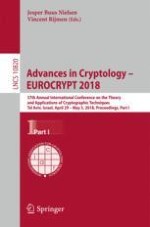
2018 | OriginalPaper | Buchkapitel
On the Bit Security of Cryptographic Primitives
verfasst von : Daniele Micciancio, Michael Walter
Erschienen in: Advances in Cryptology – EUROCRYPT 2018
Aktivieren Sie unsere intelligente Suche, um passende Fachinhalte oder Patente zu finden.
Wählen Sie Textabschnitte aus um mit Künstlicher Intelligenz passenden Patente zu finden. powered by
Markieren Sie Textabschnitte, um KI-gestützt weitere passende Inhalte zu finden. powered by